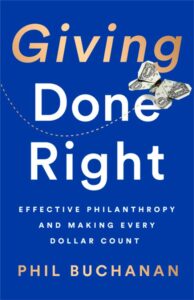What We’re Reading: “Giving Done Right” by Phil Buchanan
Giving Done Right by Phil Buchanan
A guide for thoughtful philanthropy

In Giving Done Right: Effective Philanthropy and Making Every Dollar Count, Phil Buchanan educates his audience by offering practical advice for all levels of giving.
As President of the Center for Effective Philanthropy for nearly 20 years, Buchanan deeply understands the charitable giving sector and what issues confront donors when they are making contributions, large or small. He also believes that a push for “business thinking” has taken over the discussion of effective philanthropy in recent years, and that it’s time for “thoughtful givers and nonprofit leaders… to stand up and make clear that their work is uniquely challenging – and uniquely valuable – and as such requires its own approach and discipline.”
“Giving done right” according to Buchanan requires understanding the organizations you want to fund, and the people and communities you seek to affect. It also requires humility and patience.
In his book, Buchanan writes about many different aspects of the nonprofit world and charitable giving. For this blog post, I am focusing on his examination of personal giving and some of the things you need to know when deciding to make a donation.
Buchanan says every giver needs to answer the same question, “How do I channel my giving effectively to make the greatest difference?” He points out that the majority of households give to many local charities – such as schools, religious organizations, community foundations, food banks, or homeless shelters. When considering giving, he recommends carving out a significant portion for where you feel it will do the most good.
But how can you determine what will do the most good? Buchanan tells us to research the nonprofits we are interested in helping, evaluate the outcomes of the nonprofits we are already giving to, and believe in their respective causes. For example, he suggests contacting someone on the board you might know, or contacting the Executive Director, to learn more about the organization. There are also many ways to give, and a challenge can often be finding the right organization based on your interests and goals, as well as your level of giving.
Finally, Buchanan tells us that sometimes you just need to say no when receiving a phone call asking to support your local police or fire department, or for cancer research. He admits it’s hard to say no, but you should save your contributions for the organizations that you choose thoughtfully, based on your personal goals and strategies. In other words, you need to feel confident about the impact of your giving based on your own research and due diligence, so you can feel good about how your money will be used and the difference your giving will make.
Years ago, when I first went to work for the Knott Foundation, I changed my own way of giving to be more in line with Buchanan’s advice. I found that the nonprofit world was much larger than I had ever anticipated, and through my work, I was able to research and learn about the ones I found particularly interesting, and I started to change my way of giving.
“Giving Done Right” is a must read for anyone who wants to be thoughtful about their philanthropic giving, as well as anyone who wants to learn more how unique and complex the nonprofit sector really is.
